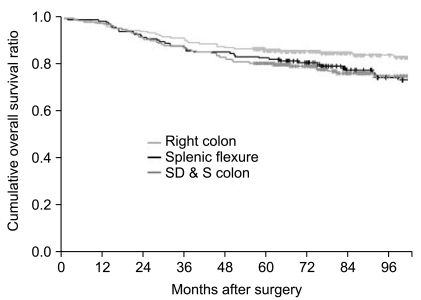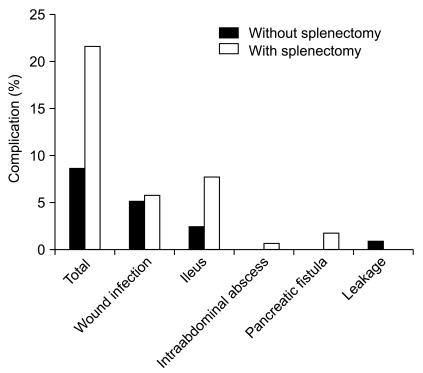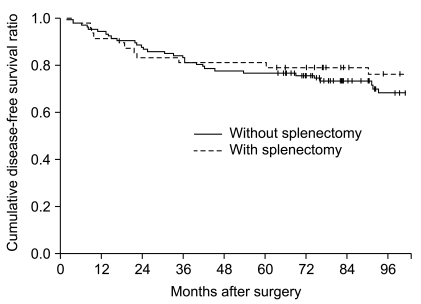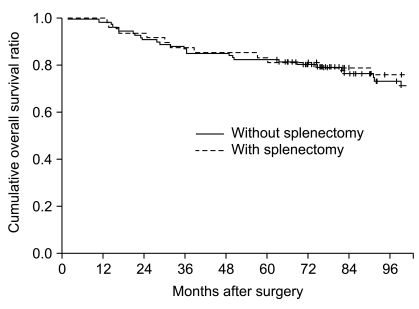Cancer Res Treat.
2010 Jun;42(2):69-76.
Clinicopathologic Characteristics, Surgical Treatment and Outcomes for Splenic Flexure Colon Cancer
- Affiliations
-
- 1Department of Surgery, University of Ulsan College of Medicine and Asan Medical Center, Seoul, Korea. jckim@amc.seoul.kr
- 2Korea Institute of Radiological & Medical Sciences, Korea Cancer Center Hospital, Seoul, Korea.
Abstract
- PURPOSE
This current study examined the clinicopathologic characteristics of patients with splenic flexure (SF) colon cancer and the association with the surgical outcomes to find the optimal procedure to treat this malady.
MATERIALS AND METHODS
A total of 167 operated patients with SF colon cancer were consecutively recruited between 1993 and 2003. The clinicopathological, operative and survival data was reviewed and analyzed.
RESULTS
For the SF colon cancer patients, the proportion of males was higher than that for the right-sided colon patients or the sigmoid-descending junction & sigmoid (SD & S) colon patients (p< or =0.05, respectively) and the age at the time of diagnosis was younger (p< or =0.05). Obstruction was more frequent in the patients with SF colon cancer than that for the patients with colon cancer at other sites (p< or =0.001). The incidence of mucinous adenocarcinoma for the SF patients was similar to that for the patients with right-sided colon cancer, but it was higher than that for the patients with SD & S colon cancer (11.4% vs. 6.5%, p=0.248 or 2.5%, respectively, p=0.001). Disease-free and overall survival did not differ between the patients who underwent a left hemicolectomy and extended surgery such as combined splenectomy or subtotal colectomy. Multivariate analysis showed that old age (> or =60 years) and a N1-2 and M1 status were the independent risk factors for overall survival.
CONCLUSION
The SF colon cancers exhibited exclusively different characteristics as compared to colon cancers at other site colon cancers. It appears that left hemicolectomy was generally sufficient for a satisfactory oncological outcome, obviating concurrent splenectomy.
Keyword
MeSH Terms
Figure
Reference
-
1. Ministry of Health and Welfare of Korea Central Cancer Registry 2005. Annual report of the Korea Central Cancer Registry. 2008.2. Nawa T, Kato J, Kawamoto H, Okada H, Yamamoto H, Kohno H, et al. Differences between right- and left-sided colon cancer in patient characteristics, cancer morphology and histology. J Gastroenterol Hepatol. 2008; 23:418–423. PMID: 17532785.
Article3. Glebov OK, Rodriguez LM, Nakahara K, Jenkins J, Cliatt J, Humbyrd CJ, et al. Distinguishing right from left colon by the pattern of gene expression. Cancer Epidemiol Biomarkers Prev. 2003; 12:755–762. PMID: 12917207.4. Birkenkamp-Demtroder K, Olesen SH, Sorensen FB, Laurberg S, Laiho P, Aaltonen LA, et al. Differential gene expression in colon cancer of the caecum versus the sigmoid and rectosigmoid. Gut. 2005; 54:374–384. PMID: 15710986.
Article5. Meguid RA, Slidell MB, Wolfgang CL, Chang DC, Ahuja N. Is there a difference in survival between right-versus left-sided colon cancers? Ann Surg Oncol. 2008; 15:2388–2394. PMID: 18622647.6. Aldridge MC, Phillips RK, Hittinger R, Fry JS, Fielding LP. Influence of tumour site on presentation, management and subsequent outcome in large bowel cancer. Br J Surg. 1986; 73:663–670. PMID: 3742184.
Article7. Levien DH, Gibbons S, Begos D, Byrne DW. Survival after resection of carcinoma of the splenic flexure. Dis Colon Rectum. 1991; 34:401–403. PMID: 2022146.
Article8. Nakagoe T, Sawa T, Tsuji T, Jibiki M, Nanashima A, Yamaguchi H, et al. Carcinoma of the splenic flexure: multivariate analysis of predictive factors for clinicopathological characteristics and outcome after surgery. J Gastroenterol. 2000; 35:528–535. PMID: 10905361.
Article9. Nakagoe T, Sawai T, Tsuji T, Jibiki M, Ohbatake M, Nanashima A, et al. Surgical treatment and subsequent outcome of patients with carcinoma of the splenic flexure. Surg Today. 2001; 31:204–209. PMID: 11318121.
Article10. Corman ML. Colon and Rectal Surgery. 2005. 5th ed. Philadelphia: Lippincott Williams & Wilkins.11. Du W, Mah JT, Lee J, Sankila R, Sankaranarayanan R, Chia KS. Incidence and survival of mucinous adenocarcinoma of the colorectum: a population-based study from an Asian country. Dis Colon Rectum. 2004; 47:78–85. PMID: 14719155.
Article12. Yu YS, Kim HC, Park SJ, Yu JH, Kim JS, Yu CS, et al. Characteristic Clinical Behaviors of and Prognosis for Mucinous Adenocarcinomas in the Colon and Rectum. J Korean Soc Coloproctol. 2003; 19:379–385.13. Griffith JD. Surgical anatomy of the blood supply of the distal colon. Ann R Coll Surg Engl. 1956; 51:241–256.14. Khafagy MM, Stearns MW Jr. Carcinoma of the splenic flexure. Dis Colon Rectum. 1973; 16:504–507. PMID: 4543805.
Article15. Killingback MJ. Extended resection for carcinoma of the splenic flexure. Proc R Soc Med. 1970; 63(Suppl):136–137. PMID: 5525483.16. Walfisch S, Stern H. Use of thoracoabdominal incision for cancer of the splenic flexure in the obese patient. Dis Colon Rectum. 1989; 32:169–170. PMID: 2914531.
Article17. Sadler GP, Gupta R, Foster ME. Carcinoma of the splenic flexure--a case for extended right hemicolectomy? Postgrad Med J. 1992; 68:487. PMID: 1437940.
Article18. Danforth DN Jr, Thorbjarnarson B. Incidental splenectomy: a review of the literature and the New York Hospital experience. Ann Surg. 1976; 183:124–129. PMID: 1247309.19. Eaton MA, Valentine J, Jackson MR, Modrall G, Clagett P. Incidental splenic injury during abdominal vascular surgery: a case-controlled analysis. J Am Coll Surg. 2000; 190:58–64. PMID: 10625233.20. Konstadoulakis MM, Kymionis GD, Leandros E, Ricaniadis N, Manouras A, Krespis E, et al. Long term effect of splenectomy on patients operated on for cancer of the left colon: a retrospective study. Eur J Surg. 1999; 165:583–587. PMID: 10433144.21. Varty PP, Linehan IP, Boulos PB. Does concurrent splenectomy at colorectal cancer resection influence survival? Dis Colon Rectum. 1993; 36:602–606. PMID: 7684667.
Article22. Wolters U, Keller HW, Muller JM, Pichlmaier H. Effect of accidental splenectomy on long-term outcome in colorectal tumor surgery. Chirurg. 1991; 62:47–50. PMID: 2026069.23. Davis CJ, Ilstrup DM, Pemberton JH. Influence of splenectomy on survival rate of patients with colorectal cancer. Am J Surg. 1988; 155:173–179. PMID: 3341531.
Article24. Compton C, Fenoglio-Preiser CM, Pettigrew N, Fielding LP. American joint committee on cancer prognostic factors consensus conference: colorectal working group. cancer. 2000; 88:1739–1757. PMID: 10738234.
- Full Text Links
- Actions
-
Cited
- CITED
-
- Close
- Share
- Similar articles
-
- Three Surgical Approaches of Laparoscopic Splenic Flexure Mobilization
- Laparoscopic Surgery for Splenic Flexure Colon Cancer
- Long-term oncologic outcomes of laparoscopic surgery for splenic flexure colon cancer are comparable to conventional open surgery
- Volvulus of the splenic flexure of the colon
- The Significance of Synchronous Colorectal Polyps in Colon Cancer Proximal to the Splenic Flexure





